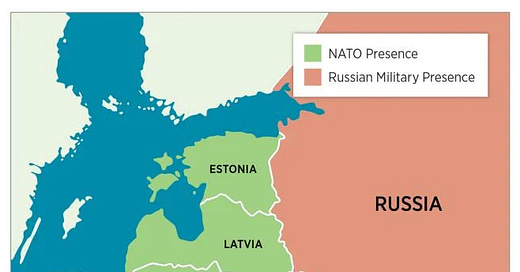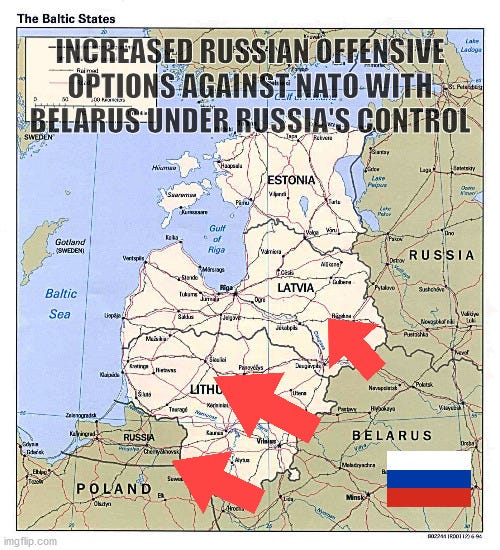Russia’s Kaliningrad exclave (basically the former East Prussia captured and annexed from Germany after World War II) is a thorn in NATO’s side. But let’s not curl up into a fetal position over it, okay? General Grant admonished his generals to cause the enemy concerns when they kept pointing out what Lee might do to Grant’s planned offensive:
Oh, I am heartily tired of hearing about what Lee is going to do. Some of you always seem to think he is suddenly going to turn a double somersault, and land in our rear and on both of our flanks at the same time. Go back to your command, and try to think what we are going to do ourselves, instead of what Lee is going to do.
Situated between Poland and Lithuania, both members of the European Union and NATO, Kaliningrad Oblast is a Russian exclave on the southern coast of the Baltic Sea, as well as the westernmost region of the Russian Federation. The oblast covers approximately 5,800 square miles, with a population of around one million, and its capital is the city of Kaliningrad. As an exclave, the territory shares no borders with mainland Russia and receives much of its supplies by rail via Belarus and Lithuania, although a sea route of some 600 miles connects its port to that of St. Petersburg through international waters. Kaliningrad enjoys the only Russian port free from ice year round, hosting the Baltic Fleet.
The peculiar political-territorial nature of the Kaliningrad Oblast has been an unpredictable geopolitical dilemma and an obstacle to Euro-Atlantic integration of the Baltic region since 1991. At the same time, Moscow has considered the oblast a building block to guarantee its interests in the Baltic and a means to break NATO’s lines of communication. Today, the Russia-Ukraine war has again highlighted the Kaliningrad Oblast’s strategic significance, especially should that conflict expand beyond Ukraine’s borders.
The land threat is highlighted this way:
Tactically, in the event of conflict, Russia could form a land bridge from Belarus to the Kaliningrad exclave along the so-called Suwałki Gap, severing the Baltic states, including Lithuania, from other members of the Atlantic Alliance. In this scenario, troops stationed in Lithuania as part of a German-led NATO brigade would be surrounded and cut off from Central Europe. In addition, the deployment of long-range antiaircraft, surface-to-air, and surface-to-surface missiles could deny NATO forces access to maritime and land areas in the region.
Regarding the ability to deny NATO forces access to the sea, air space, and land surrounding Kaliningrad—which absolutely would be a major threat to reinforcing Poland and points north of the Suwalki Gap in the Baltic States—we are not without counter-measures, as an Air Force general explained prior to the Winter War of 2022:
U.S. forces believe they know how to crack Kaliningrad, Gen Jeff Harrigan, commander of U.S. Air Forces in Europe, told reporters including Breaking Defense’s Sydney Freedberg, Jr. “We train to that,” Harrigian said. “We think through those plans all the time, and… if that would ever come to fruition, we’d be ready to execute.”
“It would be a multi-domain, very timely and effective capability that we would bring to ensure we have the access we need in that environment,” Harrigian added.
Sure, we can’t sink Kaliningrad. But we can scrape it clean. So deal with the real problem but don’t panic over the Russian anti-access/area denial (A2/AD) threat.
I believe the ground threat to the Suwalki Gap from Kaliningrad is grossly exaggerated despite the creation of the 11th Russian corps in that region. And that was before the Winter War of 2022:
The 11th Army Corps isn’t really a new formation. It’s a new grouping of existing formations under a single headquarters that itself answers to the Russian navy’s Baltic Fleet. The corps oversees a motorized division, a separate motorized regiment, artillery, rockets, air-defense troops and supporting units.
Before Russia widened its war in Ukraine starting in late February, there were no fewer than 12,000 Russian troops in Kaliningrad with around 100 T-72 tanks, a couple hundred BTR fighting vehicles, Msta-S howitzers and BM-27 and BM-30 rocket-launchers. The 11th Army Corps oversaw most of these forces.
The “corps” isn’t like one of our capable corps. It is really more like a division. The truth is that is insufficient to defend the region let alone attack east to threaten the Suwalki Gap. NATO had more troops to defend West Berlin during the Cold War (three brigades from America, Britain, and France) which were not expected to survive a war behind Russia’s frontline.
Not that I’m opposed to fortifying NATO borders to contain the Russians, as Lithuania is doing along its Nemen River border with Kaliningrad. This reflects a general plan of Estonia, Latvia, Lithuania, and Poland to fortify all their borders with Russia.
The author of the linked Forbes article rightly notes that the Russian Kaliningrad ground threat would be serving as an “anvil” for a Russian “hammer” coming in from the east. And that’s assuming Russia rebuilds 11th Corps after sending the units off to die in Ukraine, as the story discusses.
The hammer would likely have to come from Belarus. Yet Russia doesn’t have an army based in Belarus notwithstanding the Anschluss Russia imposed on Belarus prior to invading Ukraine, using troops deployed into Belarus to target Kiev.
In the past, Russia practiced moving through Belarus under an air defense umbrella to nullify the NATO air threat that Harrigan was confident could be directed at Kaliningrad. Russia’s Zapad 2017 exercise highlighted that objective:
If there is one thing that Russia has learned from American interventions since Kosovo, it is that American-led Western air power is awesome. And if the Western air power is allowed to work over your army, your army can be crippled and pinned in place to avoid destruction.
So the major requirement for a Russian invasion is not the ground forces to defeat the Belarusian military or even to defeat NATO ground forces (which could not intervene in force rapidly), but the mobile air defenses to hold off American-led air power to cripple the Russian army before it can settle into defensive lines in Belarus or into offensive positions prior to advancing west.
In many ways, Belarus may be the most important territory in modern Europe—the new Belgium. While that’s a military problem in war, it should be a high priority to use diplomacy or information war to nullify that threat.
Although threats to Estonia and Latvia which directly border Russia don’t require Russian control and use of Belarus territory.
But even that threat in a worst-case scenario could be countered if NATO considers the capture of Kaliningrad to be the first offensive operation of any war that Russia initiates against the Baltic States:
The Kaliningrad garrison should face the same fate as West Berlin would have endured if Russia launches a war on NATO. It should fall.
So yes, a counterattack from Poland into the Baltic states would have Kaliningrad on its left flank, but that's more reason to wipe out that enclave first. That cleans up the left flank and paves the way for NATO naval and marine forces to operate against the coastal flank of the Russians controlling the Baltic states.
Really, NATO troops standing in Kaliningrad are the ultimate suppression of Russian A2/AD capabilities.
While it is wise to consider the threat Russian forces in Kaliningrad pose to NATO rather than dismiss their capabilities, it is far more productive to force Russia to worry about how NATO will conduct multidomain somersaults to wreck Russian plans.
NOTE: The top map is from the Proceedings article linked.





